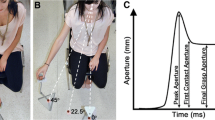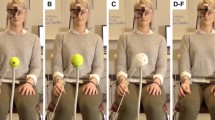Abstract
The present experiment aimed at verifying whether the spatial alignment effect modifies kinematic parameters of pantomimed reaching-grasping of cups located at reachable and not reachable distance. The cup’s handle could be oriented either to the right or to the left, thus inducing a grasp movement that could be either congruent or incongruent with the pantomime. The incongruence/congruence induced an increase/decrease in maximal finger aperture, which was observed when the cup was located near but not far from the body. This effect probably depended on influence of the size of the cup body on pantomime control when, in the incongruent condition, cup body was closer to the grasp hand as compared to the handle. Cup distance (near and far) influenced the pantomime even if it was actually executed in the same peripersonal space. Specifically, arm and hand temporal parameters were affected by actual cup distance as well as movement amplitudes. The results indicate that, when executing a reach-to-grasp pantomime, affordance related to the use of the object was instantiated (and in particular the spatial alignment effect became effective), but only when the object could be actually reached. Cup distance (extrinsic object property) influenced affordance, independently of the possibility to actually reach the target.



Similar content being viewed by others
References
Barbieri F, Buonocore A, Bernardis P et al (2007) On the relations between affordance and representation of the agent’s effector. Exp Brain Res 180:421–433
Borghi AM, Bonfiglioli C, Ricciarelli P, Rubichi S, Nicoletti R (2005) Visual hand primes and manipulable objects. In: Bara B, Barsalou L, Bucciarelli B (eds) COGSCI2005 XXVII annual conference of the cognitive science society. Lawrence ErlbaumAssociates Inc, Mahwah NJ, pp 322–327
Borghi AM, Bonfiglioli C, Ricciardelli P et al (2007) Do we access object manipulability while we categorize? Evidence from reaction time studies. In: Schalley AC, Khlentzos D (eds) Mental states: evolution function nature. John Benjamins, Philadelphia, pp 153–170
Bub DN, Masson MEJ (2010) Grasping beer mugs: on the dynamics of alignment effects induced by handled objects. J Exp Psychol Hum Percept Perform 36:341–358
Bub DN, Masson MEJ, Cree GS (2008) Evocation of functional and volumetric gestural knowledge by objects and words. Cognition 106:27–58
Costantini M, Ambrosini E, Tieri G et al (2010) Where does an object trigger an action? An investigation about affordances in space. Exp Brain Res 207:95–103
Costantini M, Committeri G, Sinigaglia C (2011) Ready both to your and to my hands: mapping the action space of others. PLoS One 6:e17923
De Stefani E, Innocenti A, Bernardi NF, Campione GC, Gentilucci M (2012) The bottle and the glass say to me: “pour!”. Exp Brain Res 218:539–549
Ellis R, Tucker M (2000) Micro-affordance: the potentiation of components of action by seen objects. Br J Psychol 91:451–471
Ferri F, Campione GC, Dalla Volta R et al (2011) Social requests and social affordances: how they affect the kinematics of motor sequences during interactions between conspecifics. PLoS One 6:e15855
Fitts P (1954) The information capacity of the human motor system in controlling the amplitude of movement. J Exp Psychol 47:381–391
Fogassi L, Gallese V, Fadiga L et al (1996) Coding of peripersonal space in inferior premotor cortex (area F4). J Neurophysiol 76:141–157
Gallivan JP, Cavina-Pratesi C, Culham JC (2009) Is that within reach? fMRI reveals that the human superior parieto–occipital cortex encodes objects reachable by the hand. J Neurosci 29:4381–4391
Gangitano M, Daprati E, Gentilucci M (1998) Visual distractors differentially interfere with the reaching and grasping components of prehension movements. Exp Brain Res 122:441–452
Gentilucci M (2002) Object motor representation and reaching–grasping control. Neuropsychologia 40:1139–1153
Gentilucci M (2003) Object motor representation and language. Exp Brain Res 153:260–265
Gentilucci M, Scandolara C, Pigarev IN, Rizzolatti DG (1983) Visual responses in the postarcuate cortex (area 6) of the monkey that are independent of eye position. Exp Brain Res 50:464–468
Gentilucci M, Fogassi L, Luppino G et al (1988) Functional organization of inferior area 6 in the macaque monkey. Exp Brain Res 71:475–490
Gentilucci M, Castiello U, Corradini ML et al (1991) Influence of different types of grasping on the transport component of prehension movements. Neuropsychologia 29:361–378
Gentilucci M, Toni I, Chieffi S, Pavesi G (1994) The role of proprioception in the control of prehension movements: a kinematic study in a peripherally deafferented patient and in normal subjects. Exp Brain Res 99:483–500
Gibson JJ (1979) The ecological approach to visual perception. Houghton-Mifflin, New York
Glover S, Dixon P (2002) Semantics affect the planning but not control of grasping. Exp Brain Res 146:383–387
Glover S, Rosenbaum DA, Graham J, Dixon P (2004) Grasping the meaning of words. Exp Brain Res 154:103–108
Goldenberg G (2009) Apraxia and the parietal lobes. Neuropsychologia 47:1449–1459
Goldenberg G, Hagmann S (1998) Tool use and mechanical problem solving in apraxia. Neuropsychologia 36:581–589
Goodale MA, Jakobson LS, Keillor JM (1994) Differences in the visual control of pantomimed and natural grasping movements. Neuropsychologia 32:1159–1178
Graziano MS (2006) Progress in understanding spatial coordinate systems in the primate brain. Neuron 51:7–9
Grosskopf A, Kuhtz-Buschbeck JP (2006) Grasping with the left and right hand: a kinematic study. Exp Brain Res 168:230–420
Hermsdörfer J, Terlinden G, Mühlau M et al (2007) Neural representations of pantomimed and actual tool use: evidence from an event-related fMRI study. Neuroimage 36(Suppl 2):T109–T118
Innocenti A, De Stefani E, Bernardi NF et al (2012) Gaze direction and request gesture in social interactions. PLoS One 7:e36390
Jeannerod M (1988) The neural and behavioural organization of goal-directed movements, vol 15. Clarendon Press, Oxford
Jeannerod M (1994) The hand and the object: the role of posterior parietal cortex in forming motor representations. Can J Physiol Pharmacol 72:535–541
Johnson-Frey SH (2004) The neural bases of complex tool use in humans. Trends Cogn Sci 8:71–78
Króliczak G, Cavina-Pratesi C, Goodman DA, Culham JC (2007) What does the brain do when you fake it? An fMRI study of pantomimed and real grasping. J Neurophysiol 97:2410–2422
Kumar S, Riddoch MJ, Humphreys G (2013) Mu rhythm desynchronization reveals motoric influences of hand action on object recognition. Front Hum Neurosci 7:66. doi:10.3389/fnhum.2013.00066
Lewis JW (2006) Cortical networks related to human use of tools. Neuroscientist 12:211–231
Loftus GR, Masson MEJ (1994) Using confidence intervals in within-subject designs. Psychon Bull Rev 4:476–490
Milner AD, Goodale MA (1995) The visual brain in action. Oxford University Press, Oxford
Oldfield RC (1971) The assessment and analysis of handedness: the Edinburgh inventory. Neuropsychologia 9:97–113
Poeck K, Lehmkuhl G (1980) Ideatory apraxia in a left-handed patient with right-sided brain lesion. Cortex 16:273–284
Sartori L, Becchio C, Bulgheroni M, Castiello U (2009) Modulation of the action control system by social intention: unexpected social requests override preplanned action. J Exp Psychol Hum Percept Perform 35:1490–1500
Tucker M, Ellis R (1998) On the relations between seen objects and components of potential actions. J Exp Psychol-Hum Percept Perform 24:830–846
Tucker M, Ellis R (2001) The potentiation of grasp types during visual object categorization. Vis Cogn 8:769–800
Acknowledgments
The work was supported by grants MIUR (Ministero dell’Istruzione, dell’Università e della Ricerca) to MG. We thank Prof. Annalisa Pelosi for the help in carrying out the statistical analyses.
Author information
Authors and Affiliations
Corresponding author
Rights and permissions
About this article
Cite this article
De Stefani, E., Innocenti, A., De Marco, D. et al. The spatial alignment effect in near and far space: a kinematic study. Exp Brain Res 232, 2431–2438 (2014). https://doi.org/10.1007/s00221-014-3943-8
Received:
Accepted:
Published:
Issue Date:
DOI: https://doi.org/10.1007/s00221-014-3943-8




